| کد مقاله | کد نشریه | سال انتشار | مقاله انگلیسی | نسخه تمام متن |
|---|---|---|---|---|
| 5782599 | 1637504 | 2017 | 14 صفحه PDF | دانلود رایگان |

- Slab-derived components in sources of the >Â 108Â Ma alkali basalts decline westward.
- Ridge between the Izanagi and Pacific plates subducted beneath the NCC in the Cretaceous.
- Northward shift of the ridge caused geochemical transitions in Cretaceous basalts.
- Lithosphere destruction is triggered by ridge subduction and slab roll-back.
Geochemical compositions of continental basalts are generally considered as the best proxy record of the chemical and isotopic evolution of subcontinental lithosphere and convective mantle. There are voluminous Cretaceous continental basalts in the North China Craton (NCC), which are mainly composed of alkali basalts with minor sub-alkali basalts. Abrupt changes in chemical and isotopic compositions of these basalts were often ascribed to subcontinental lithosphere thinning of the NCC. However, processes responsible for such changes and its implications for subcontinental lithosphere evolution remain obscure. Here we report major geochemical changes at ~ 108 Ma in the north part of the NCC. The > 108 Ma alkali basalts are characterized by negative εNd(t) and declining “island arc-like” geochemical characteristics from the east to the west, implying decreasing slab-derived components from westward subducting slabs in their metasomatized lithospheric mantle sources. In contrast, the < 108 Ma Cretaceous alkali basalts have depleted Sr-Nd isotopic compositions and “OIB-like” geochemical features. These observations suggest that westward subduction of the Paleo-Pacific plate was responsible for the Cretaceous basaltic activities in the NCC. Combined with plate reconstructions and geophysical observations, we propose that flat subduction of the “extinct” ridge between the Izanagi and the Pacific plates controlled this major transition as well as the destruction of the NCC. The transition from a supra-subduction zone environment to a within-plate extensional environment around 108 Ma is probably due to the eastward slab rollback and the northward shift of the spreading ridge.
Journal: Chemical Geology - Volume 470, 20 October 2017, Pages 93-106